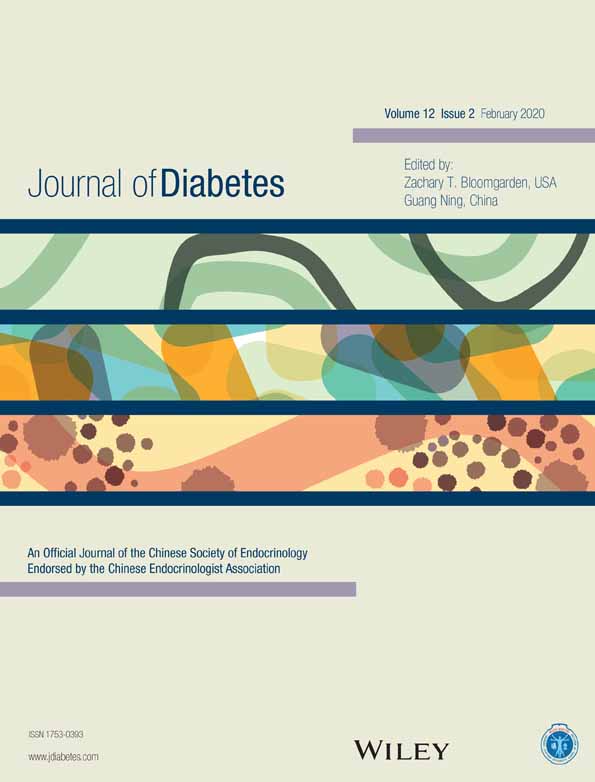Time-averaged serum uric acid and 10-year incident diabetic kidney disease: A prospective study from China
时均血清尿酸水平与十年新发糖尿病肾病:一项来自中国的前瞻性研究
Funding information: Ministry of Science and Technology of the People's Republic of China, Grant/Award Number: 2016YFC1305400; University of Michigan Health System-Peking University Health Science Center Joint Institute for Translational and Clinical Research, Grant/Award Numbers: BMU20160466, BMU2018JI012, BMU2019JI005; National Natural Science Foundation of China, Grant/Award Numbers: 81771938, 91846101, 81301296; Peking University, Grant/Award Numbers: BMU2018MX020, PKU2017LCX05
Abstract
enBackground
The association between serum uric acid (SUA) and the risk of diabetic kidney diseases (DKD) remains controversial. We aim to investigate the association between time-averaged SUA and long-term incident DKD among general population-based patients with diabetes.
Methods
Altogether 1327 patients with diabetes and without kidney disease (estimated glomerular filtration rate [eGFR] ≥ 60 mL/min/1.73m2, and without proteinuria) were included. Incident DKD were defined by the occurrence of renal function decline (eGFR<60 mL/min/1.73m2) and/or macroalbuminuria (urinary albumin-creatinine-ratio ≥ 30 mg/mM creatinine). The associations between baseline and time-averaged SUA and DKD were analyzed.
Results
The mean age was 53.7 ± 8.0. During 10.2 ± 0.4 years' follow-up, 85 (6.4%) patients developed renal function decline and 101 (7.6%) patients developed macroalbuminuria. Compared to those with time-averaged SUA in the second quartile (207-240 μM/L for women, 233-272 μM/L for men), odds ratio (OR) for renal function decline was 1.92 (95% confidence interval [CI], 1.02 to 3.62; P = .04) among those with SUA in the top quartile (women≥285 μM/L; men≥324 μM/L); and OR for macroalbuminuria was 1.86 (95% CI 1.01 to 3.43; P = .05) among those with SUA in the bottom quartile (women ≤207 μM/L; men ≤233 μM/L)). No significant associations were observed between baseline SUA with incident DKD.
Conclusions
Long-term exposure to both high and low SUA level are associated with increased risk of incident DKD among patients with diabetes.
摘要
zh背景
血清尿酸水平与糖尿病肾病发生风险的关系仍存在争议。我们的目的是在以一般人群为基础的糖尿病患者中, 研究时均血清尿酸水平与长期糖尿病肾病事件发生之间的关系。
方法
共纳入1327例糖尿病不合并肾病的患者(肾小球滤过率≥60 mL/min/1.73m2, 无蛋白尿)。新发糖尿病肾病事件的定义为肾功能下降(肾小球滤过率<60 mL/min/1.73m2)和/或大量蛋白尿(尿白蛋白-肌酐比值≥30 mg/mM肌酐)。我们分别分析了基线和时均血清尿酸水平与新发糖尿病肾病的相关性。
结果
患者平均年龄53.7±8.0岁。在10.2±0.4年的随访期间, 85例(6.4%)患者出现肾功能下降, 101例(7.6%)患者出现大量蛋白尿。与时均尿酸水平为第二4分位的患者相比(女性:207-240 μM/L, 男性:233-272 μM/L), 时均尿酸水平为最高4分位的患者(女性:≥285 μM/L; 男性:≥324 μM/L)发生肾功能降低的比值比为1.92(95% CI [1.02, 3.62];P=0.04);而时均尿酸水平为最低4分位的患者(女性:≤207 μM/L; 男性:≤233 μM/L)发生大量白蛋白尿的比值比为1.86 (95% CI [1.01, 3.43]; P=0.05)。未发现基线尿酸水平与新发糖尿病肾病的关系。
结论
长期暴露于高水平和低水平的血清尿酸浓度与糖尿病患者发生肾病的风险增加有关。
CONFLICT OF INTEREST
The authors declare that they have no conflict of interest.




